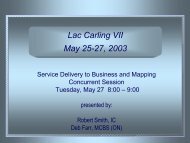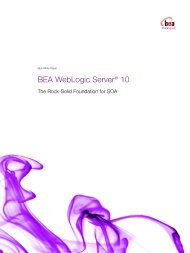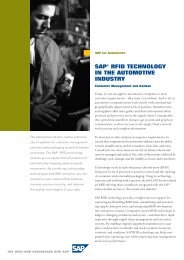The hidden costs of data migration. - IT World Canada
The hidden costs of data migration. - IT World Canada
The hidden costs of data migration. - IT World Canada
- No tags were found...
Create successful ePaper yourself
Turn your PDF publications into a flip-book with our unique Google optimized e-Paper software.
IBM Global Technology ServicesNovember 2008<strong>The</strong> <strong>hidden</strong> <strong>costs</strong> <strong>of</strong> <strong>data</strong> <strong>migration</strong>.Strategies for reducing <strong>costs</strong> and quickly achievingreturn on investment
<strong>The</strong> <strong>hidden</strong> <strong>costs</strong> <strong>of</strong> <strong>data</strong> <strong>migration</strong>.Page 2Contents2 Executive summary3 Introduction5 What is driving <strong>data</strong> <strong>migration</strong>?5 Data <strong>migration</strong> challenges6 Hidden <strong>costs</strong> <strong>of</strong> <strong>migration</strong>7 S<strong>of</strong>tek <strong>data</strong> mobility solutions10 <strong>The</strong> bottom lineExecutive summary<strong>The</strong>re are many challenges associated with <strong>data</strong> <strong>migration</strong>. First, the amount <strong>of</strong><strong>data</strong> to be migrated is increasing as quickly as storage capacity grows. Second,<strong>data</strong> <strong>migration</strong> is problematic for most users. Next, applications need 24x7 <strong>data</strong>availability, so that <strong>IT</strong> departments have only narrow downtime windows foressential system maintenance and don’t want to “waste” this time migrating <strong>data</strong>.Data centers usually support multiple operating systems—mainframe, UNIX,Micros<strong>of</strong>t ® Windows ® and Linux ® technology—with the mix being determinedby the specifc applications in use. Finally, there usually is hardware from morethan one storage vendor in the <strong>data</strong> center—further increasing complexity.®<strong>The</strong> organization thinking about <strong>data</strong> <strong>migration</strong> should consider the followingkey factors—and how the S<strong>of</strong>tek <strong>data</strong> <strong>migration</strong> products can help:Key factors Description S<strong>of</strong>tek <strong>data</strong> <strong>migration</strong> s<strong>of</strong>twareScalabilityApplication availabilityApplicationperformanceVendor independenceHeterogeneousoperating system (OS)and storage supportStorage capacity continues togrow at a rate <strong>of</strong> 50 percentannually as <strong>migration</strong> needsincrease each year with morestorage coming <strong>of</strong>f <strong>of</strong> lease.Data availability requirementshave increased with24x7 applications such ase-mail and online commerce.Performance measurementsmust take into considerationhow quickly <strong>data</strong> is copiedfrom the source to targetand balanced againstnetwork bandwidth andsystem overhead.Multiple storage vendorshave unique requirementsfor <strong>migration</strong> and different<strong>migration</strong> techniques, addingcomplexity to the process.Multiple operating systemsand storage arrays add tocomplexity in the <strong>data</strong> center.Can scale <strong>migration</strong>s from movinga single volume to migratingterabytes <strong>of</strong> <strong>data</strong> to new, largerstorage locally or globallyHelps keep businesses runningbecause applications stay onlinewhile volumes are relabeled andinput/output (I/O) is transferred duringpatent-pending Dynamic SwapHelps ensure applicationperformance with dynamicthrottling/tuningHelps lower storage <strong>costs</strong> withS<strong>of</strong>tek’s simple, comprehensiveand proven methodology to assess,plan and validate <strong>migration</strong>sSupports all operating systems andmulti-storage array environments
<strong>The</strong> <strong>hidden</strong> <strong>costs</strong> <strong>of</strong> <strong>data</strong> <strong>migration</strong>.Page 3HighlightsOvertime work and lease overlapare <strong>hidden</strong> <strong>costs</strong> <strong>of</strong> <strong>data</strong> <strong>migration</strong>.IntroductionIn March 2005, S<strong>of</strong>tek surveyed 700 end users on how <strong>data</strong> <strong>migration</strong> impactstheir organizations. <strong>The</strong> results <strong>of</strong> the survey—carried out in conjunction witha leading industry analyst frm, Enterprise Strategy Group—show the full range<strong>of</strong> challenges such as unexpected downtime and cost overruns that users facein migrating <strong>data</strong>. <strong>The</strong> study found that many <strong>of</strong> these cost overruns remain“<strong>hidden</strong>,” because they involve overtime work and lease overlap. In addition, itfound that even though tools are available to help users address their <strong>migration</strong>challenges, many <strong>IT</strong> managers are either not aware <strong>of</strong> these tools or have not yetimplemented them. Exposing <strong>hidden</strong> <strong>costs</strong> <strong>of</strong> <strong>data</strong> <strong>migration</strong> and providing solu -tions to address them will help <strong>IT</strong> managers provide nonstop <strong>data</strong> <strong>migration</strong>smore effectively and efficiently.When you add them up, <strong>hidden</strong><strong>data</strong> <strong>migration</strong> <strong>costs</strong> can exceedthe cost <strong>of</strong> <strong>data</strong> <strong>migration</strong> tools.Users cite cost as one <strong>of</strong> the key factors keeping them from implementing new<strong>data</strong> <strong>migration</strong> tools. <strong>The</strong>y believe that, along with the actual purchase price <strong>of</strong>new technology, related <strong>costs</strong>—such as training, installation and pr<strong>of</strong>essionalservices—can add up to an expensive bundle. However, they typically overlookthe fact that the <strong>hidden</strong> <strong>costs</strong> <strong>of</strong> maintaining the status quo can be even greaterthan implementing new technology.In this paper, S<strong>of</strong>tek looks at the <strong>hidden</strong> <strong>costs</strong> <strong>of</strong> <strong>data</strong> <strong>migration</strong> that wererevealed by the survey, including <strong>costs</strong> resulting from:• Unplanned downtime• Delaying the purchase <strong>of</strong> new, better storage• Lease overruns• Overpaying for capacity• <strong>The</strong> need for additional storage hardware• Exceeding planned staff time• Exceeding <strong>data</strong> <strong>migration</strong> budget• Exceeding scheduled downtime• Lack <strong>of</strong> validation procedures to ensure <strong>data</strong> integrity.
<strong>The</strong> <strong>hidden</strong> <strong>costs</strong> <strong>of</strong> <strong>data</strong> <strong>migration</strong>.Page 4HighlightsAs storage capacity continues togrow exponentially, it’s importantto reevaluate the advantages and<strong>costs</strong> <strong>of</strong> <strong>data</strong> <strong>migration</strong> tools.With storage capacity continuing to grow at a rate <strong>of</strong> 50 percent annually, <strong>data</strong><strong>migration</strong> is a fact <strong>of</strong> life for the <strong>IT</strong> manager. Evaluating the <strong>costs</strong> and <strong>hidden</strong><strong>costs</strong> <strong>of</strong> <strong>migration</strong>s, along with new <strong>migration</strong> tools, can provide a new perspectiveon how to approach moving <strong>data</strong>.This paper demonstrates how to do the following:• Provide a simple, unified approach to <strong>data</strong> mobility by moving <strong>data</strong>:- Across virtually all operating systems, and storage vendors/platforms- At almost all volume, block and file (<strong>data</strong>set) levels- Using a common management console- Locally or over distance• Reduce the cost, complexity and risk <strong>of</strong> moving <strong>data</strong> with:- Nondisruptive storage/server replacement and consolidation designed totake full advantage <strong>of</strong> high-performance arrays with no lease overlaps- Tiered storage and workload balancing that minimizes outages- Nonstop distance replication with automated restore- A proven methodology for nonstop <strong>data</strong> mobility- Easy installation and use,with no additional hardware/s<strong>of</strong>tware• Ensure continuous application availability through:- Nondisruptive <strong>data</strong> movement,so applications remain online- Patent-pending Dynamic Swap technology- Dynamic performance throttling
<strong>The</strong> <strong>hidden</strong> <strong>costs</strong> <strong>of</strong> <strong>data</strong> <strong>migration</strong>.Page 5Highlights<strong>The</strong> key driver <strong>of</strong> <strong>data</strong> <strong>migration</strong> istechnology refresh.What is driving <strong>data</strong> <strong>migration</strong>?According to S<strong>of</strong>tek’s survey, technology refresh—replacing an array or serverwith a new one — is the number-one driver <strong>of</strong> <strong>data</strong> <strong>migration</strong>, followed byconsolidation and relocation. <strong>The</strong> storage hardware and server replacementinvolved in technology refresh, coupled with the expiration <strong>of</strong> storage equip -ment leases, means that storage managers have to move <strong>data</strong> on a regular basis.In addition, storage and server capacity are acquired at a rate typically rangingfrom 25 to 50 percent annually to accommodate <strong>data</strong> and application growth. So,every year—or even more <strong>of</strong>ten—a typical organization acquires storage technol -ogy to replace arrays on which lease or maintenance agreements are expiring,and it acquires additional capacity to accommodate anticipated growth.With the explosive growth <strong>of</strong> storage and with older storage coming <strong>of</strong>f <strong>of</strong>lease, the need for <strong>data</strong> <strong>migration</strong> is ever increasing. Additionally, applicationssuch as e-mail and online banking run 24x7, meaning increased requirementsfor <strong>data</strong> availability, even during <strong>data</strong> <strong>migration</strong>s.Increasing requirements for 24x7<strong>data</strong> availability mean less tolerancefor application downtown.Data <strong>migration</strong> challengesOne <strong>of</strong> the main issues that emerged from S<strong>of</strong>tek’s user survey is that applica -tion downtime is the biggest overall challenge to <strong>data</strong> <strong>migration</strong>. As a resultthe majority <strong>of</strong> <strong>migration</strong>s are conducted on weekends.<strong>The</strong> survey also found that while <strong>migration</strong>s are routine, they can be riskyevents, with 83 percent <strong>of</strong> <strong>migration</strong>s experiencing problems. Unexpecteddowntime was cited as the leading problem. Other problems include technicalcompatibility issues, <strong>data</strong> corruption, application performance issues and<strong>data</strong> loss.
<strong>The</strong> <strong>hidden</strong> <strong>costs</strong> <strong>of</strong> <strong>data</strong> <strong>migration</strong>.Page 6HighlightsTo minimize risk, most organizationsconduct <strong>migration</strong>s on weekends—which leads to costly overtime.In addition, users talked about how migrating <strong>data</strong> can be a complex process, withmost <strong>migration</strong>s taking more than two weeks to plan and involving fve peopleto implement. Add to this the composition <strong>of</strong> the typical <strong>data</strong> center—where -multiple operating systems and multiple storage vendors increase the complexity.Attesting to the fact that <strong>data</strong> <strong>migration</strong> is a fact <strong>of</strong> life for the <strong>IT</strong> manager,39 percent <strong>of</strong> those surveyed said that they perform <strong>migration</strong> on a weekly ormonthly basis. But with the downtime problems, the majority conduct their<strong>migration</strong>s on weekends to avoid overall risk. So, weekend <strong>migration</strong>s meancostly overtime. Because many companies lack suffcient numbers <strong>of</strong> <strong>IT</strong> staff,weekend <strong>migration</strong>s also can result in unhappy employees.<strong>The</strong>re is no getting around the fact that <strong>data</strong> <strong>migration</strong>s are diffcult, but theyhave to be done. <strong>IT</strong> managers do their best to plan the most effcient <strong>migration</strong>,estimating the best time to take applications down, how many peoplethey will need, and how much it will cost. But the survey found that the plan<strong>of</strong>ten goes awry.Since the cost <strong>of</strong> downtime can bemillions <strong>of</strong> dollars per hour, <strong>migration</strong>can impact the bottom line.Hidden <strong>costs</strong> <strong>of</strong> <strong>migration</strong>Considering that the cost <strong>of</strong> downtime can be up to millions <strong>of</strong> dollars per hour,migrating <strong>data</strong> can have a significant impact on an organization’s bottom line.Though <strong>data</strong> <strong>migration</strong> is conducted during planned downtime, the processseldom works out as planned. <strong>The</strong> best solution would be to eliminate the needfor downtime and conduct <strong>data</strong> <strong>migration</strong>s when applications are running.Delaying storage purchases as a way to avoid the risks or problems <strong>of</strong> moving<strong>data</strong> is also costly. Organizations can overpay for capacity, lease or mainte -nance overlap. And as long as they are using their old equipment, they won’tbe able to access cost-effciencies that new storage hardware can provide.
<strong>The</strong> <strong>hidden</strong> <strong>costs</strong> <strong>of</strong> <strong>data</strong> <strong>migration</strong>.Page 7HighlightsMost organizations rely on userfeedback to determine the success<strong>of</strong> their <strong>data</strong> <strong>migration</strong>s.Most survey participants said they rely on their end users to validate whethertheir <strong>data</strong> <strong>migration</strong> has been successful or not. Without validation procedures,problems show up when the business is running. <strong>The</strong> result can be downtimeduring working hours that the weekend <strong>data</strong> move was intended to avoid.From the discussion above, it is clear that users face very real issues in <strong>IT</strong>environments where the need for storage grows rapidly and downtime is notan option. Depending on the business and the amount <strong>of</strong> <strong>data</strong> being moved,there is no question that online <strong>data</strong> <strong>migration</strong> solutions that do not requireapplication downtime can help reduce the <strong>hidden</strong> <strong>costs</strong> <strong>of</strong> <strong>data</strong> <strong>migration</strong>,including its significant administrative <strong>costs</strong>. Online solutions can take therisk out <strong>of</strong> moving <strong>data</strong> by eliminating downtime, streamlining the <strong>migration</strong>process and ensuring <strong>data</strong> integrity.Data mobility solutions canreduce the cost, complexity andrisk involved in moving <strong>data</strong>.S<strong>of</strong>tek <strong>data</strong> mobility solutionsIBM Nonstop Data Mobility s<strong>of</strong>tware provides a simple and unified approachdesigned to move live <strong>data</strong> over any distance, regardless <strong>of</strong> server platform or -storage vendor. S<strong>of</strong>tek’s Nonstop solutions can reduce the cost, complexity and risk <strong>of</strong>moving <strong>data</strong>, thereby increasing application availability and customer choice.Since 1996, S<strong>of</strong>tek has set the industry standard for <strong>data</strong> <strong>migration</strong>, movingterabytes <strong>of</strong> <strong>data</strong> for more than 60 percent <strong>of</strong> Fortune 1000 companies. S<strong>of</strong>tekcan meet the key requirements and provide benefits in virtually all <strong>data</strong><strong>migration</strong> scenarios:• Technology refresh —S<strong>of</strong>tek solutions can eliminate lease or maintenanceoverlap charges; they can enable <strong>data</strong> <strong>migration</strong> across array platformsand can assure <strong>data</strong> integrity during the process.• Consolidation — S<strong>of</strong>tek solutions enable <strong>IT</strong> organizations to easily reconfigurevolumes or logical unit number (LUN) sizes, use an automated andrepeatable process and perform the <strong>migration</strong> with minimal downtime.
<strong>The</strong> <strong>hidden</strong> <strong>costs</strong> <strong>of</strong> <strong>data</strong> <strong>migration</strong>.Page 8HighlightsS<strong>of</strong>tek <strong>data</strong> <strong>migration</strong> productscan help with a variety <strong>of</strong> issuesrelated to distance, availabilityand performance.• Relocation—S<strong>of</strong>tek solutions can help bring systems back online quickly,minimizing revenue impact and avoiding <strong>data</strong> loss or corruption.• Improvements to application performance—S<strong>of</strong>tek solutions provide workloadbalancing, tiered storage and the ability to perform maintenanceduring business hours.S<strong>of</strong>tek’s <strong>data</strong> <strong>migration</strong> products provide solutions to a full range <strong>of</strong><strong>migration</strong> needs, including:• Migration over any distance—Data can migrate from and to almost anylocation, locally or globally.• Application availability —Applications can continue running during the<strong>migration</strong>; volumes are relabeled and I/O is transferred using DynamicSwap.• Application performance — Dynamic throttling/tuning ensuresapplication performance.• Assessment, planning and validation—S<strong>of</strong>tek solutions and processes arebased on proven methodologies.• Open, heterogeneous storage support—S<strong>of</strong>tek solutions enable moving <strong>data</strong>in multi-storage array environments, to any storage architecture and onvirtually all major operating systems and platforms.TDMF s<strong>of</strong>tware—setting the standard in <strong>data</strong> <strong>migration</strong><strong>The</strong> cornerstone to S<strong>of</strong>tek’s enterprise <strong>data</strong> <strong>migration</strong> s<strong>of</strong>tware <strong>of</strong>ferings is theS<strong>of</strong>tek Transparent Data Migration Facility (TDMF ) family <strong>of</strong> products. Forthe past ten years, the TDMF name has become synonymous with nondisruptive
<strong>The</strong> <strong>hidden</strong> <strong>costs</strong> <strong>of</strong> <strong>data</strong> <strong>migration</strong>.Page 9HighlightsNow considered the gold standard,TDMF technology enables organizationsto move <strong>data</strong> withoutinterrupting applications.<strong>data</strong> <strong>migration</strong> in multivendor storage environments. Today, TDMF technologyis recognized as the de-facto “gold-standard” in heterogeneous, host-baseds<strong>of</strong>tware for performing online <strong>migration</strong>s in enterprise environments.TDMF s<strong>of</strong>tware enables <strong>IT</strong> organizations to move <strong>data</strong> at the volume or blocklevel between different storage vendors or versions—with no interruption to theapplications running the business. <strong>The</strong> TDMF solution provides local or global<strong>data</strong> <strong>migration</strong> for technology refresh, consolidation, relocation and performanceimprovement.®<strong>The</strong> TDMF product suite currently supports IBM z/O S ,UNIX, Micros<strong>of</strong>tWindows, and Linux environments.With zDMF technology, organi -zations can easily upgrade andconsolidate storage and fine-tuneperformance on the fly.zDMF s<strong>of</strong>tware—the solution for mainframe <strong>data</strong>set <strong>migration</strong>Building on its enterprise <strong>data</strong> <strong>migration</strong> heritage, S<strong>of</strong>tek also <strong>of</strong>fers S<strong>of</strong>tekzOS Data Migration Facility (zDMF), the industry’s first product for mainframe<strong>data</strong>set-level <strong>migration</strong>. zDMF technology is architected from the groundup to nondisruptively migrate mainframe <strong>data</strong>sets. This ability provides a longsought-afterway to easily upgrade and consolidate storage, provide on-the-fyperformance tuning and deliver tiered storage.<strong>The</strong> bottom line<strong>The</strong> bottom line is that S<strong>of</strong>tek’s products and expertise help <strong>IT</strong> organizations toavoid “wasted time” in moving <strong>data</strong>. More important, organizations can quicklyimprove the return on investment (ROI) <strong>of</strong> their storage systems by keepingapplications running, eliminating lease overlap <strong>costs</strong> and avoiding budget overruns.
<strong>The</strong> <strong>hidden</strong> <strong>costs</strong> <strong>of</strong> <strong>data</strong> <strong>migration</strong>.Page 10HighlightsFollowing is an example <strong>of</strong> how one large company was able to leverage itsinvestment in S<strong>of</strong>tek technology to achieve ROI and overcome the <strong>hidden</strong> <strong>costs</strong><strong>of</strong> the status quo.Before implementing the S<strong>of</strong>tek solution, the company experienced the following:• This international media conglomerate migrated 75TB <strong>of</strong> <strong>data</strong> ninetimes per year.• When performing these <strong>migration</strong>s, the company experienced 90 minutes<strong>of</strong> application outage per server, with an average <strong>of</strong> 15 servers experiencingthe outage.• A conservative estimate <strong>of</strong> the planned downtime cost was US $ 2,500 per hour.• <strong>The</strong> average burdened hourly wage <strong>of</strong> staff that performs <strong>migration</strong>swas US $51.By taking advantage <strong>of</strong> S<strong>of</strong>tektechnology, one company not onlysaved US$841,000 in lease extensions,but also reduced downtimeand staff effort by 66 percent.After implementing the S<strong>of</strong>tek solution:• By enabling <strong>migration</strong> onto newer volumes more quickly, S<strong>of</strong>tek’s TDMFsolution enabled the company to avoid lease extensions <strong>of</strong> US $841,000annually, based on an average <strong>of</strong>:- Overlapping capacity <strong>of</strong> 337TB- A monthly per-TB cost <strong>of</strong> US $555 overlap 1- Average overlap <strong>of</strong> four and a half months• S<strong>of</strong>tek TDMF technology reduced downtime and staff effort by 66 percent.
<strong>The</strong> <strong>hidden</strong> <strong>costs</strong> <strong>of</strong> <strong>data</strong> <strong>migration</strong>.Page 11HighlightsBased on the assumptions outlined above, the estimated two-year financial impact<strong>of</strong> TDMF s<strong>of</strong>tware on operations <strong>of</strong> this company is outlined in the chart below.For this company, the S<strong>of</strong>tekpayback was a 53 percent ROIin just 27 months.Hidden <strong>costs</strong> versus S<strong>of</strong>tek solution (technology refresh example)Status quo Implementing S<strong>of</strong>tek SavingsCost <strong>of</strong> downtime US$1,012,500 US$334,125 US$678,375Cost <strong>of</strong> staff(specifc to <strong>migration</strong>)Cost <strong>of</strong> overlappingleasesUS$52,908 US$17,571 US$35,337US$1,683,315 0 US$1,683,315TOTAL US$2,748,723 US$351,696 US$2,397,027Savings summaryHidden <strong>costs</strong>Investment in S<strong>of</strong>tek s<strong>of</strong>tware, services,and maintenance over two yearsNet savingsUS$2,397,027US$1,375,000US$1,022,027ROI53 percentPayback timeCost <strong>of</strong> NOT investing in Nonstop DataMobility Solution27 monthsUS$99,876/month(after payback period ends)This example shows that Nonstop Data Mobility Solutions can achievefaster ROI by:• Keeping applications running all the time• Decreasing unexpected downtime• Reducing staff <strong>costs</strong>• Implementing new storage today, not tomorrow• Eliminating lease overlaps.
In summary, the best solution is to conduct <strong>data</strong> <strong>migration</strong> whileapplications are running.For more informationTo learn more about how S<strong>of</strong>tek products can help you conduct <strong>data</strong><strong>migration</strong> while your applications are running, visit:ibm.com/services/storage© Copyright IBM Corporation 2008IBM Global ServicesRoute 100Somers, NY 10589U.S.A.Produced in the United States <strong>of</strong> AmericaNovember 2008All Rights ReservedIBM, the IBMlogo, ibm.com, MVS,Nonstop Data Mobility, S<strong>of</strong>tek,Transparent Data Migration Facility(TDMF), z/OS, and other referenced IBMproducts and services are trademarks <strong>of</strong>International Business MachinesCorporation in the United States, othercountries or both.Other company, product and servicenames may be trademarks or servicemarks <strong>of</strong> others.References in this publication to IBMproducts or services do not imply that IBMintends to make them available in allcountries in which IBM operates.SDD03010-USEN-1 Depreciation on 1TB <strong>of</strong> <strong>data</strong>, given a purchasecost per TB <strong>of</strong> US $20,000 (or US $0.02/MB) isUS $555 per TB per month, assuming a 36-monthuseful life for the hardware.GTW01279-USEN-01










